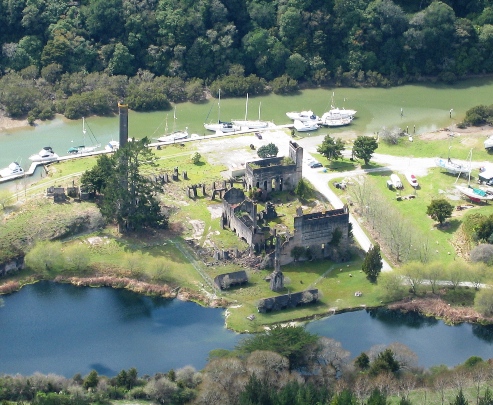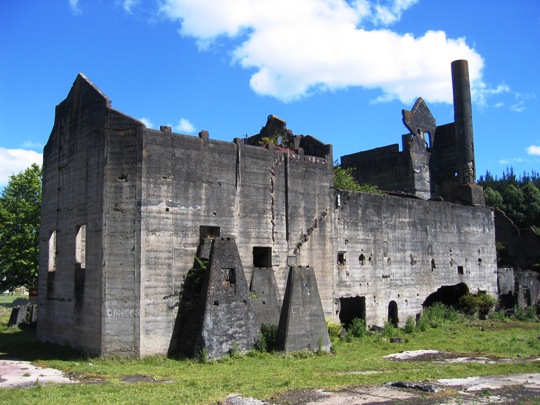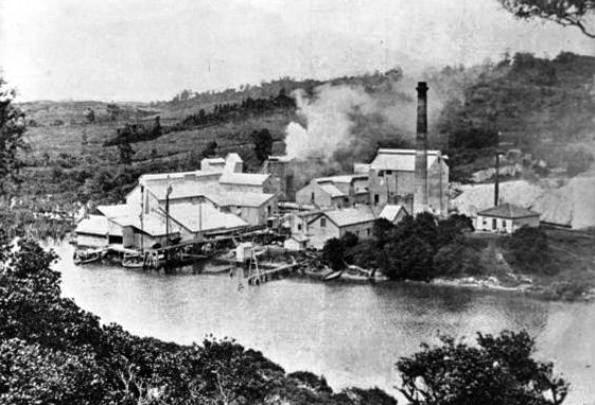Incorporating visible remains from the early 1880s onwards, the former Wilson’s Cement Works at Warkworth is nationally and internationally significant as the first factory to commercially produce Portland cement in Australasia, and possibly the Southern Hemisphere. The complex is also of high value for its connections with the earlier development and production of industrial-scale hydraulic lime in New Zealand. Both hydraulic lime and cement were important to the country’s construction industry, including as essential ingredients of concrete. Plain concrete, in particular, appears to have been more commonly used in New Zealand than most other countries in the nineteenth century. Reinforced concrete was also rapidly adopted in New Zealand at an internationally early stage. Land beside the Mahurangi River is traditionally associated with Ngati Manuhiri. In 1841, the area was acquired by the Crown as part of the Mahurangi Purchase. European settlers soon recognised that local limestone might be useful for producing lime, a component of products that included mortar for construction work. By 1849 or 1850, stone-based lime was being locally produced. John Southgate is said to have manufactured a more water-resistant product, hydraulic lime, on the current cement works site in the early 1850s. In 1857, the site formed part of a large property obtained by two other producers, Auckland entrepreneurs Walter Combes and William Crush Daldy: at this time, it contained a lime kiln, a hut and a jetty. In 1869, the property was purchased by Nathaniel Wilson (1836-1919), who through his commitment to improving production techniques became known as the ‘father’ of cement manufacture in New Zealand. Wilson initially pioneered the production of fine-ground hydraulic lime, which gained wide currency after establishment of the firm John Wilson and Company (with Nathaniel’s brothers, John and James) in 1878 because this material was easier to package and use. From the mid-1880s, the business also became the first in Australasia, and possibly the Southern Hemisphere, to develop and produce Portland cement in marketable quantities. Surviving remnants of the period before cement production include a set of lime kilns and a concrete residence, both erected using hydraulic lime. The latter structure was one of several workers’ houses on the site, and probably built at a similar time to other showcase structures erected by the company from 1880 onwards to advertise their products in and around Auckland. In 1882, the complex also included a boiler stack, grinding equipment, storage sheds, tramways, and separate wharves for loading lime and discharging fuel. The lime was obtained from a large quarry immediately beside the main buildings. Wilsons’ developed its Portland cement in 1884, offering it for sale the following year. New purpose-built equipment included two large vertical kilns and a pug mill. Hydraulic lime production continued, including for structures such as the Pots Hill Reservoir, Sydney, which kept the works operating during a subsequent period of economic depression. In 1903-4, when the business became a public limited liability company, American-made rotary kilns were introduced to produce cement more effectively. At this time, the firm manufactured some 20,000 tons annually and employed 180 workmen. Notable structures erected using Wilsons’ cement included Grafton Bridge (1907-10) in Auckland, which had the longest single concrete span in the world when built. In 1907-8, the company doubled the size of its plant and capacity at a cost of £30,000. In 1913, it was reported to have ‘the largest output of any cement manufactory in the Dominion’. As a visible reflection of this, an imposing 42-metre reinforced concrete chimney designed by the manager, T.H. Wilson, was erected in 1916. The outbreak of the First World War in 1914 and increasing competition in the marketplace, however, ultimately led to financial losses. In 1918, three major cement companies, including the Warkworth-based enterprise, amalgamated to form Wilsons (NZ) Portland Cement Company. Cement production subsequently shifted to a newer factory at Portland, near Whangarei, in 1924, followed by hydraulic lime production four years later. In 1930, most of the land was sold to Benjamin Hamilton, storekeeper of Warkworth. During the Second World War (1939-45), the complex was damaged during a demolition exercise carried out by the Home Guard and United States military personnel. Full public ownership of the site occurred in 2003. The surviving complex, including its associated quarry and tailings, can be considered to have aesthetic significance for its striking visual appearance and setting; archaeological significance for its potential to provide information about the development of the hydraulic lime and concrete industries in New Zealand; architectural significance as a rare purpose-built complex for the manufacture of lime and cement manufacture in the nineteenth- and early twentieth centuries; historical significance for its connections with the early development of these industries in New Zealand, with notable figures such as Nathaniel Wilson, and with the role of industrial enterprise and labour during this period; and technological and scientific significance as the birthplace of industrially-produced Portland cement in Australasia and possibly the Southern Hemisphere. The complex forms part of a wider landscape of significance, which includes the associated Manager’s House (Former) (List No. 2600).



Location
List Entry Information
Overview
Detailed List Entry
Status
Listed
List Entry Status
Historic Place Category 1
Access
Private/No Public Access
List Number
82
Date Entered
6th June 1983
Date of Effect
6th June 1983
City/District Council
Auckland Council
Region
Auckland Council
Extent of List Entry
Extent includes the land described as Secs 1-2 SO 379415 (RTs 405520-405521, NZ Gazette 2008, p.363), Lot 4 DP 204384 (RT NA131A/962), Lot 4 DP 157198 (NA94B/901), Lot 3 DP 54387 (NZ Gazette 1995, p.1788) and Allots 373-374 Parish of Mahurangi (Sec 62 Conservation Act 1987), North Auckland Land District, and the buildings and structures known as Wilson’s Hydraulic Lime and Cement Works Ruins thereon.
Legal description
Secs 1-2 SO 379415 (RTs 405520-405521, NZ Gazette 2008, p.363), Lot 4 DP 204384 (RT NA131A/962), Lot 4 DP 157198 (NA94B/901), Lot 3 DP 54387 (NZ Gazette 1995, p.1788) and Allots 373-374 Parish of Mahurangi (Sec 62 Conservation Act 1987), North Auckland Land District
Stay up to date with Heritage this month
